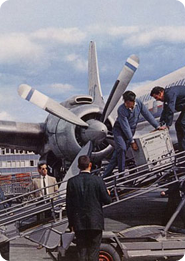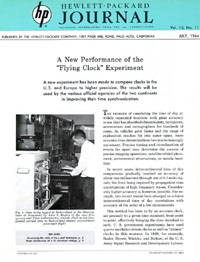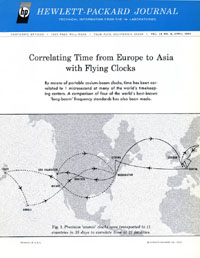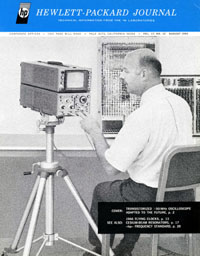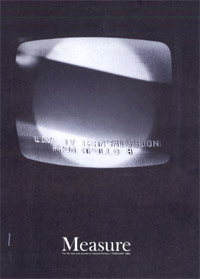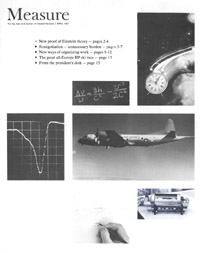Our HP Memory Project now has Reconstituted
one of the Most Symbolic Scientific Experiments
of the 20th Century---the Flying Clock
After our HP Memory Project recently acquired an HP 5060A Cesium Beam Frequency Standard, our Flying Clock configuration was still missing one important element. To replicate the full rack complement which flew around the world, we thankfully were the proud recipient of the HP K02-5060A Standby Power Supply.
Our fortunate windfall came from the local HP France calibration lab. Dominique Ferrand was in charge of the HP France Time & Frequency Calibration Laboratory during more than 12 years. Dominique saved the power supply from disposal when the T&F calibration facility moved in 2005. As a long-term enthusiastic supporter of the HP Memory Project, Dominique was glad to help our project with this new, and highly appreciated contribution.
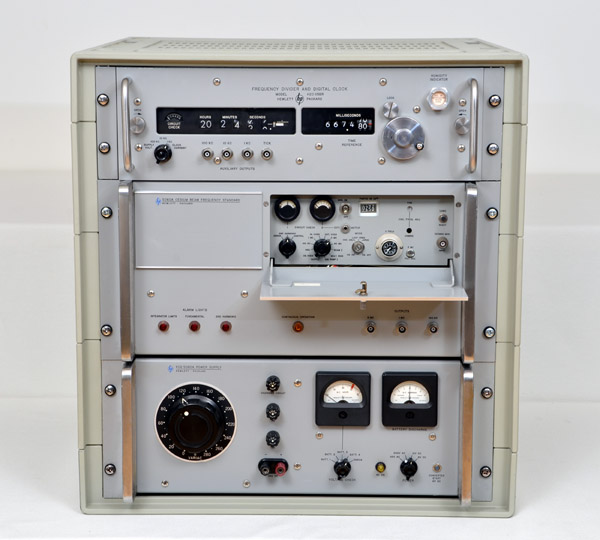 |
 Panel view of a typical "atomic" clock configuration used in the Flying Clock experiment. The cesium standard in the
middle drives HP 115BR electronic clock (top) which integrates standard frequency and also produces very accurate
electrical "ticks" based on driving frequency. The Standby Power Supply unit at bottom provides for operation
from a range of ac and dc voltages, and continued operation when AC line power is interrupted,
such as when the Flying Clock rides in a passenger seat of an international airliner.
|
1964, Introduction of the HP 5060A Cesium Beam Frequency Standard.
For fully portable operation, all the Necessary Hardware was Integrated
in a 19' Standard Rack Unit
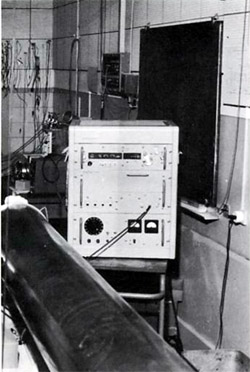 |
A size comparison between a flying clock rack
and a "long" cesium beam standard (foreground).
The more important task was comparing the two
standard frequencies.
|
In 1963, an accurate primary time reference was only available in a few national physical laboratories. These national time and frequency standards used the cesium-beam resonator technology. The heart of these installations was the beam tube, a long cylinder, with an interaction length in the order of 350 cm (about 12 feet). The obvious limitation of those exceptional frequency standards was portability !
In 1964, HP technology allowed all the physical and electronic circuitry necessary to reproduce the functionality of such atomic clocks to be enclosed into a single rack cabinet, with just a slightly lower specified accuracy of 2 parts in 1011. The result was the HP 5060A, World First Transportable Cesium Beam Atomic Clock.
Two pictures clearly illustrate the compactness of the HP 5060A compared to two examples of long-beam resonator installation.
The picture on the left shows a Hewlett Packard "flying clock" rack standing aside the "long" cesium beam standard (foreground) at the Laboratoire Suisse de Recherches Horlogères, Neuchatel, Switzerland. This long standard was considered one of the world's best cesium standards in 1964.
The picture below shows the "Long-beam" cesium resonator at National Research Council, Ottawa, Canada. It was typical of high-precision, laboratory-constructed frequency standards intercompared during flying-clock experiment. Cesium-beam standards in traveling clocks agreed with this standard to better than 1 part in 1011.
The scientific importance of this experiment was that even though the various national Cesium standards were based on atomic resonance, it was not possible to truly compare them to an adequate resolution, using radio connections. With technology demanding global time correlations for programs like the Apollo Moon shot, the Flying Clock performed beautifully in lowering the measurement uncertainty of international time.
| Another example of a long-beam cesium resonator at National Research Council, Ottawa, Canada. |
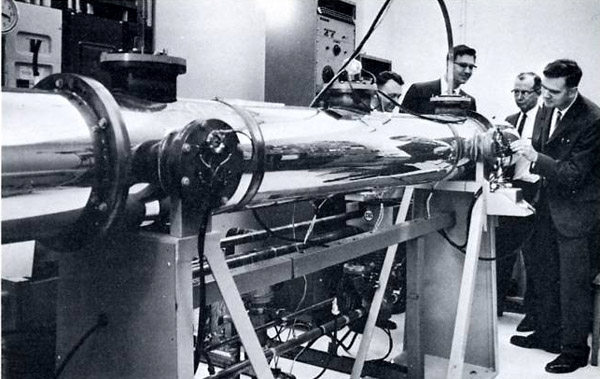 |
1964-2014, Fiftieth Anniversary of the First Flying Clock Experiment
With the HP 5060A, the FEASIBILITY of transporting compact "atomic" clocks in continuous operation to distant points by commercial airliner or other conventional transport was established by a flying clock experiment performed in the summer of 1964. That experiment correlated the time of day within a microsecond between the Observatoire de Neuchâtel in Switzerland and both the U. S. Naval Observatory and the National Bureau of Standards in the United States. It also established within 200 microseconds the propagation time of radio timing signals from Beltsville, Md., to Neuchâtel, and it provided an opportunity for intercomparing laboratory-constructed "long-beam" cesium frequency standards by way of the traveling cesium-beam standards.
 |
| The route of the 1965 flying-clock experiment |
In 1965, and 1966 two more flying clock experiments were performed with the traveling cesium-beam clocks. These experiments involved more time-keeping centers than any clock correlation experiment conducted before. Standards facilities in Japan, Hawaii, Canada, and most of the countries of western Europe were visited in the experiment. In all, time and frequency were correlated at 21 different facilities in 11 different countries.
As a result of these experiments, time scales maintained by widely-separated timekeeping laboratories have been correlated within a microsecond, an accuracy far higher than that possible by high-frequency radio broadcasts of time signals which, at intercontinental distances, have only been able to achieve accuracies in time comparisons of about 1 millisecond at best.
"Our Finest Hour," the Cesium Atomic Clock, circa 1964
In his HP Memoir chapter titled "Our Finest Hour," the Cesium Atomic Clock, circa 1964, Alan Bagley, manager of the HP Time-Frequency Division during more than 25 years, recalls:
"That’s a takeoff on the Winston Churchill WWII pronouncement, but the technology which led HP to dominate the world of time keeping was based on our best product to that time, literally our finest and most accurate hour. By using the atomic resonance of the element Cesium, we created a time standard based on atomic physics, and not the resonance of a quartz crystal. This product was also in line with our stated product and business strategy of providing extremely precise RF signals.
Using this standard "Atomic Clock," our promotional department created a well-publicized world tour, which was dubbed the “Flying Clock.” The chair-sized instrument usually occupied a first class airline seat, with standby power supplied from the baby bottle warmer outlet in the galley. The idea was to visit global standards labs including our U.S. National Standard at the U.S. Naval Observatory in Washington, D.C. Then further comparisons were made at Swiss Observatory in Neuchatel. The clock was designed to maintain accuracy for 3000 years within only one second of error, a truly remarkable leap ahead for time keeping. Just in time for the Apollo Moon mission which required precise timing to carry out the critical navigation and communications.
The HP line of Cesium standards came to completely dominate the standards world, with most large and aerospace companies buying their own resident standard. And for decades, as the communications technology moved to digital formats, the transmitters and receivers were required to be synchronized to a very precise scale. This has become even more critical as the technology moved to fiber optics which exploit data rates in the 10 giga-bit region and higher."
Alan Bagley's HP Memories are published on this website. Click HERE
A Compilation of HP Publications, for an In-depth Understanding of the "Flying Clocks" Experiment.


